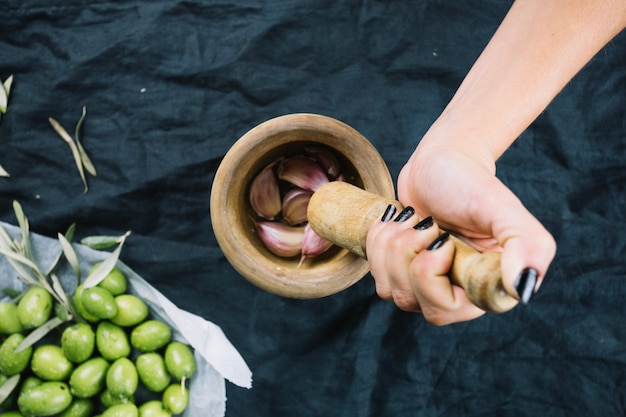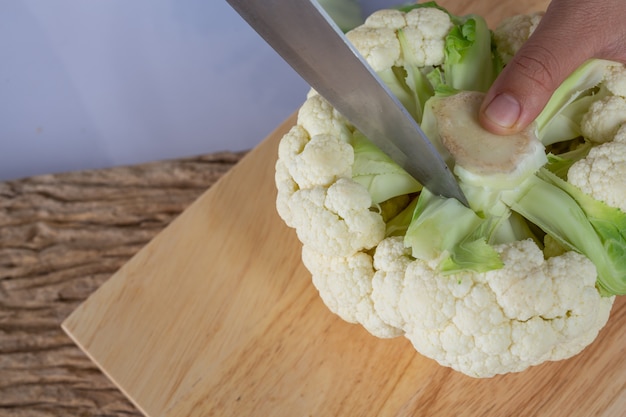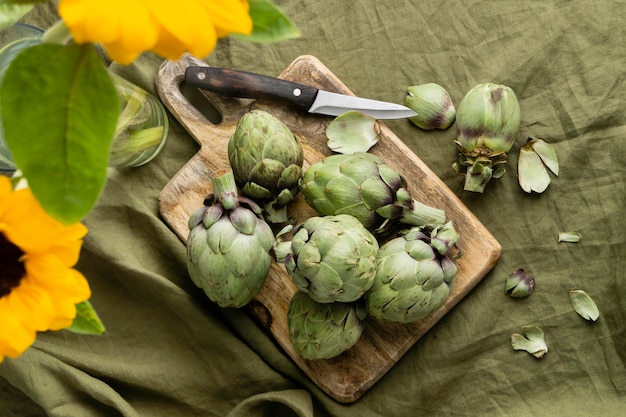Oh, artichokes. Those knobbly, enigmatic green globes that promise a delicious, slightly nutty, and surprisingly tender reward for those brave enough to tackle them. For years, I’d been intimidated by these prickly green beauties, convinced they were some culinary enigma only chefs could decipher. Then, one sunny afternoon, I decided to give them a go. Armed with a good knife and a healthy dose of curiosity, I embarked on my first artichoke adventure. And let me tell you, it was a revelation! The experience was so rewarding, so utterly delicious, that I've been hooked ever since.
Since then, I've experimented with artichokes in all sorts of ways, from simple steaming and grilling to more elaborate dishes. I've learned the art of preparing them, the best ways to cook them, and how to maximise their flavour. This journey of discovery has led me to create this ultimate guide to artichoke cooking time, packed with tips, tricks, and, of course, my personal experiences. So, whether you're a seasoned artichoke enthusiast or a curious newbie, read on and discover the secrets of these wonderful vegetables.
(Part 1) Choosing Your Artichokes

The first step on any artichoke journey is choosing the right ones. A good artichoke should be firm and heavy for its size, with tightly closed leaves and no blemishes. The leaves should be a vibrant green colour, not pale or yellow. The heart, or the ‘choke,’ should be compact and not too large.
1.1. Spotting a Prime Artichoke
Think of the artichoke as a green treasure chest. Here’s what to look for when choosing the perfect one:
- Firm and Heavy: A good artichoke should feel weighty for its size, indicating freshness and plumpness. A light artichoke may be over-mature or not fully developed, resulting in a tougher texture and less flavour.
- Closed Leaves: The leaves should be tightly packed together, suggesting the artichoke is young and tender. If the leaves are open or loose, the artichoke may be over-mature or have started to dry out.
- Vibrant Green: The colour of the leaves should be a bright, fresh green, not dull or yellowed. A dull or yellowed colour indicates that the artichoke has been sitting for a while and might not be as fresh.
- Compact Choke: The heart, also known as the 'choke,' should be compact and not too large. A large choke might indicate that the artichoke is over-mature and could have a tough, stringy texture.
- No Bruises or Blemishes: Avoid artichokes with any signs of damage or discolouration. These blemishes can indicate that the artichoke has been mishandled and may not be as fresh or flavourful.
1.2. Artichoke Varieties: A World of Flavours
Did you know there are different types of artichokes? Each one offers its unique flavour profile and texture. Here are a few popular varieties:
- globe artichoke: The classic choice, known for its large, bulbous shape, tender heart, and slightly nutty flavour. Globe artichokes are commonly found in Mediterranean cuisine, where they are often braised, grilled, or stuffed.
- Roman Artichoke: These are smaller, more delicate artichokes with a slightly sweeter flavour than their globe counterparts. Roman artichokes are often used in salads or as a side dish due to their tender texture and milder flavour.
- French Artichoke: Also known as ‘Camosun’ artichokes, these have a distinct, almost spinach-like flavour and are often favoured for their vibrant green colour. French artichokes are well-suited for grilling or sautéing as their flavour intensifies with heat.
(Part 2) Preparing Your Artichokes

Now that you've selected the perfect artichoke, it's time to prepare it for cooking. This may seem intimidating, but trust me, it’s much easier than you think. Just a few simple steps and you’ll be ready to embark on the next stage of your artichoke adventure.
2.1. Trimming the Basics
The first step is to trim the tough outer leaves and any prickly parts. This is where a sharp knife comes in handy. I always use a good quality chef's knife for this task, but a sturdy paring knife will also do the trick.
- Snip the Top: Remove the top inch or so of the artichoke, including the pointy, thorny leaves. These leaves are tough and fibrous and won't be enjoyable to eat.
- Trim the Stem: Cut the base of the stem to create a flat surface for the artichoke to sit on. This makes it easier to handle and ensures even cooking.
- Strip the Leaves: Starting from the base, remove the tough, outer leaves. You can tell which leaves to remove by their texture; they’ll be more rigid and thicker than the tender inner leaves. You’ll likely remove about 3-4 layers of leaves, leaving the tender inner leaves for eating.
2.2. A Dip in the Lemon Bath
Once the artichoke is trimmed, it's essential to prevent it from turning brown. This is where a lemon bath comes in handy. Simply rub the cut surfaces with a lemon wedge or splash them with some lemon juice. This helps preserve their bright colour and prevents them from oxidising. The citric acid in the lemon juice reacts with the artichoke's natural enzymes, preventing browning and keeping the artichoke looking fresh.
2.3. Preparing the Heart (The Choke)
The heart of the artichoke, often called the 'choke,' is the most prized part, but it needs a bit of extra attention before cooking. The fuzzy, hairy part (the choke) needs to be removed. Here's how to do it:
- Scoop It Out: Carefully scoop out the fuzzy choke with a spoon or a small knife. You can also cut it away with a sharp knife. Be careful not to remove too much of the tender heart underneath.
- Give it a Rinse: Rinse the inside of the artichoke with cold water to remove any remaining fuzz or debris. This ensures a clean and enjoyable eating experience.
(Part 3) Cooking Your Artichokes

Now for the fun part! There are many ways to cook artichokes, each bringing its own unique flavour and texture. From simple steaming and grilling to more elaborate braising and stuffing, there's an artichoke cooking method for every taste and occasion. Let's explore some popular techniques.
3.1. The Art of Steaming
Steaming artichokes is a classic method that retains their delicate flavour and texture. It's simple, quick, and a great way to enjoy their natural goodness. Steaming allows the artichoke to cook gently and evenly, resulting in a tender, succulent heart and flavorful leaves.
- Steam it Up: Place the artichokes in a steamer basket over boiling water. Cover the pot with a lid and steam for about 25-35 minutes, or until the leaves are tender when pierced with a fork. The steam will penetrate the artichoke and cook it from the inside out, creating a tender and juicy result.
- Add a Touch of Flavour: To infuse the artichokes with extra flavour, you can add a few herbs like thyme, bay leaves, or lemon slices to the steamer pot. The herbs will release their aromas into the steam, adding a subtle but delicious flavour to the artichokes.
3.2. The Grilling Delight
Grilling artichokes adds a smoky, charred flavour that's simply irresistible. It's perfect for a summer barbecue or a light, healthy dinner. Grilling brings out a delicious smoky flavour and creates a beautiful char on the artichoke, enhancing its natural taste and texture.
- Prepare for Grilling: Cut the artichokes in half lengthwise, then brush the cut sides with olive oil and season with salt and pepper. You can also add other herbs and spices like garlic powder, paprika, or oregano for extra flavour. The olive oil helps to prevent sticking and adds moisture, while the seasoning enhances the artichoke's flavour profile.
- Grill it Up: Place the artichoke halves on a preheated grill and cook for about 15-20 minutes, turning them occasionally, until the leaves are tender and slightly charred. The heat of the grill will caramelize the sugars in the artichoke, creating a sweet and smoky flavour.
3.3. The Braising Bonanza
Braising artichokes is a delightful way to create a rich, complex flavour. It's perfect for a hearty, comforting meal or a sophisticated dinner party. Braising in liquid allows the flavours to meld and intensify, creating a depth of flavour that's impossible to achieve with other cooking methods.
- Get Braising: Place the artichokes in a dutch oven or a large pot with a lid. Add some wine, broth, or even water, along with herbs, spices, and vegetables like onions, carrots, and celery. Bring to a simmer, cover the pot, and braise for about 40-50 minutes, or until the artichokes are tender. The liquid will infuse the artichokes with flavour and create a beautiful sauce.
- Spice it Up: Braising allows you to experiment with various flavour combinations. You can add aromatic spices like star anise, cloves, or coriander seeds, or use fresh herbs like rosemary, thyme, or parsley. These flavour combinations will enhance the artichoke's natural flavour and create a symphony of tastes.
3.4. The Stuffed Sensation
Stuffed artichokes are a feast for the eyes and the taste buds. They're a versatile dish that can be adapted to any occasion. Stuffing artichokes allows you to create a hearty and satisfying dish that's perfect for sharing or enjoying as a main course.
- Stuffed with Delight: Cut the artichokes in half lengthwise and scoop out the hearts. You can use these scooped-out hearts for other dishes. Then, fill the artichoke halves with your favourite stuffing. Some popular choices include sausage and breadcrumb stuffing, spinach and ricotta stuffing, or even a simple garlic and herb stuffing. The stuffing will soak up the artichoke's juices and create a delicious, flavourful filling.
- Bake to Perfection: Place the stuffed artichokes in a baking dish, drizzle with olive oil, and bake in a preheated oven at 350°F (175°C) for about 45-60 minutes, or until the stuffing is cooked through and the artichokes are tender. The oven will gently cook the stuffing and the artichoke, creating a tender and flavorful dish.
(Part 4) Cooking Time: A Guide
Now, let's get to the heart of the matter: cooking time. The exact cooking time for artichokes depends on their size, the cooking method, and your desired level of tenderness. But here's a general guide to give you a starting point:
| Cooking Method | Cooking Time |
|---|---|
| Steaming | 25-35 minutes |
| Grilling | 15-20 minutes |
| Braising | 40-50 minutes |
| Baking (stuffed) | 45-60 minutes |
Remember, these are just estimates. It's always best to check the artichokes with a fork or a sharp knife to make sure they're cooked to your liking. If the leaves are tender and easily pierceable, your artichokes are ready. You don't want to overcook them, as they can become mushy and lose their flavour.
(Part 5) Serving Your Artichoke Masterpiece
Your artichoke journey is almost complete, and now it's time to savour your creation. There are many ways to enjoy artichokes, from simple to elegant. Here are some serving tips and ideas.
5.1. The Art of Eating
Eating artichokes can seem a little tricky at first, but it's actually quite simple and surprisingly satisfying.
- From Bottom to Top: Start by pulling off the outer leaves one by one. Dip the fleshy bottom of the leaf in your chosen dipping sauce, scrape the tender part with your teeth, and discard the tough leaf. You'll be left with the tender heart, which is the most delicious part of the artichoke.
- Reach the Heart: Once you reach the heart, it's time to dig in! The heart is the most tender and flavorful part, and it can be eaten on its own or with a dipping sauce. You can use a fork to scoop out the heart and enjoy it with your favourite sauce.
5.2. Dipping Delights: A Flavorful Journey
Dipping sauces are essential to elevate your artichoke experience. There are endless possibilities, but here are a few favourites:
- Classic Olive Oil and Lemon: A simple but delicious combination, perfect for showcasing the natural flavour of the artichoke. Simply combine olive oil and lemon juice in a bowl and season with salt and pepper. The acidity of the lemon juice cuts through the richness of the olive oil, creating a refreshing and tangy dipping sauce.
- Garlic Aioli: A rich and creamy sauce made with garlic, mayonnaise, and lemon juice. It's a perfect balance of tangy, creamy, and garlicky flavours. The garlic adds a pungent flavour, while the mayonnaise provides a creamy texture, and the lemon juice adds a touch of brightness.
- hollandaise sauce: A classic, buttery sauce made with egg yolks, lemon juice, and clarified butter. It's a decadent treat for those who love a rich, indulgent sauce. The rich, creamy texture of hollandaise sauce complements the delicate flavour of the artichoke, making it a truly decadent experience.
5.3. Artichoke Inspirations: From side dishes to Main Courses
Artichokes are incredibly versatile and can be incorporated into a wide range of dishes. Here are a few ideas to inspire your culinary adventures.
- Side Dish Superstar: Steamed or grilled artichokes make a fantastic side dish to complement any main course. They add a touch of elegance and flavour to a meal, offering a unique contrast to grilled meats, roasted vegetables, or seafood.
- Salad Star: Add artichoke hearts to salads for a delightful crunch and a touch of Mediterranean flavour. Their slightly nutty and slightly sweet flavour complements a variety of salad ingredients, such as tomatoes, cucumbers, and olives.
- Pasta Perfection: Incorporate artichoke hearts into your favourite pasta dishes for an earthy, nutty flavour. They can be added to creamy pasta sauces, tossed with fresh herbs and lemon juice, or used as a topping for a simple pasta dish.
- Pizza Power: Top your pizza with artichoke hearts for a unique and delicious combination. They can be paired with other toppings, such as spinach, mushrooms, or goat cheese, to create a flavourful and satisfying pizza experience.
- Soup Sensations: Add artichoke hearts to soups for a hearty and flavourful meal. They can be used in creamy vegetable soups, hearty bean soups, or lighter broths, adding a unique flavour and texture.
(Part 6) Storage and Shelf Life
To ensure you get the most out of your artichokes, it's crucial to store them properly. Here are some tips to keep them fresh and delicious.
6.1. Refrigeration Rules
Artichokes are best stored in the refrigerator for up to 3-5 days. Store them in a plastic bag or wrap them in paper towels to prevent them from drying out. Storing them in the refrigerator helps to slow down the ripening process, keeping them fresh and flavorful for longer.
6.2. Freezing for Later
You can also freeze artichokes for later use. To freeze, trim and steam them as usual, then blanch them for 2 minutes in boiling water. Drain well and cool completely. Then, package them in freezer bags and store them in the freezer for up to 6 months. Freezing allows you to preserve artichokes for later use, ensuring that you can enjoy them even when they're out of season.
(Part 7) artichoke benefits: A Culinary Delight with Health Perks
Beyond their delectable flavour and texture, artichokes offer several health benefits. They are packed with nutrients and antioxidants, making them a valuable addition to any diet. Including artichokes in your diet can provide a variety of health benefits, contributing to your overall well-being.
7.1. Nutrient Powerhouse
Artichokes are rich in vitamins, minerals, and fibre. They are an excellent source of vitamin C, folate, potassium, and magnesium. They also contain antioxidants that protect against cell damage and inflammation. These nutrients are essential for maintaining overall health, boosting immunity, and promoting healthy cell function.
7.2. Digestive Aid
The fibre in artichokes helps promote digestive health and regularity. They can also aid in weight management and blood sugar control. The fibre in artichokes acts as a prebiotic, promoting the growth of beneficial bacteria in the gut, which is essential for digestive health.
7.3. Liver Support
Artichokes contain cynarin, a compound believed to support liver function and detoxify the body. Cynarin is a natural compound found in artichokes that has been shown to have beneficial effects on liver health, promoting detoxification and protecting against liver damage.
7.4. Heart Health
Artichokes are a good source of potassium, which is essential for maintaining healthy blood pressure. They also contain antioxidants that can protect against heart disease. The combination of potassium and antioxidants helps to support heart health, reducing the risk of cardiovascular disease and promoting optimal heart function.
(Part 8) Beyond the Basics: Exploring artichoke recipes
Now that you have a solid understanding of artichoke basics, let's explore some exciting recipes that showcase the versatility and flavour of this wonderful vegetable. These recipes provide a starting point for your artichoke adventures, allowing you to explore different flavour profiles and cooking techniques.
8.1. Simple and Delicious: steamed artichokes with Garlic Aioli
This classic recipe highlights the natural flavour of the artichoke and is perfect for a light and healthy meal. The steamed artichokes retain their delicate flavour, while the garlic aioli adds a pungent and creamy flavour, creating a delightful combination.
- Ingredients:
- 4 artichokes
- 1 lemon, cut into wedges
- 1/2 cup olive oil
- 2 cloves garlic, minced
- 1/4 cup mayonnaise
- 1 tablespoon lemon juice
- Salt and pepper to taste
- Instructions:
- Trim the artichokes and rub them with lemon wedges.
- Steam the artichokes for 25-35 minutes, or until tender.
- To make the aioli, combine the olive oil, minced garlic, mayonnaise, and lemon juice in a bowl. Season with salt and pepper to taste.
- Serve the steamed artichokes with the garlic aioli.
8.2. Hearty and Satisfying: Braised Artichokes with Sausage and White Beans
This comforting dish is perfect for a chilly evening or a family gathering. The rich flavours of sausage, white beans, and artichokes come together beautifully in this simple yet satisfying recipe. The braising process allows the flavours of the sausage, beans, and artichokes to meld and intensify, creating a rich and comforting dish.
- Ingredients:
- 2 artichokes, trimmed
- 1 pound italian sausage, casings removed
- 1 onion, chopped
- 2 cloves garlic, minced
- 1 (15-ounce) can white beans, drained and rinsed
- 1 (14.5-ounce) can diced tomatoes, undrained
- 1 cup chicken broth
- 1/4 cup chopped fresh parsley
- Salt and pepper to taste
- Instructions:
- Cut the artichokes into quarters.
- Brown the sausage in a large Dutch oven over medium heat. Remove the sausage from the pot and set aside.
- Add the onion and garlic to the pot and cook until softened.
- Stir in the white beans, diced tomatoes, chicken broth, and artichoke quarters. Bring to a simmer, then add the sausage back to the pot.
- Cover the pot and simmer for 30-40 minutes, or until the artichokes are tender.
- Stir in the parsley and season with salt and pepper to taste.
- Serve hot with crusty bread.
8.3. Elegant and Indulgent: Stuffed Artichokes with Spinach and Ricotta
This elegant dish is perfect for a special occasion or a romantic dinner. The creamy ricotta and earthy spinach filling create a delicious contrast to the tender artichoke hearts. The combination of ricotta cheese, spinach, and artichoke creates a symphony of textures and flavours, resulting in a truly elegant dish.
- Ingredients:
- 4 artichokes, trimmed
- 1 (10-ounce) package frozen spinach, thawed and squeezed dry
- 1 cup ricotta cheese
- 1/4 cup grated Parmesan cheese
- 2 cloves garlic, minced
- 1 egg, beaten
- 1/4 cup chopped fresh parsley
- Salt and pepper to taste
- Olive oil for drizzling
- Instructions:
- Cut the artichokes in half lengthwise and scoop out the hearts. Reserve the hearts for another use.
- In a large bowl, combine the spinach, ricotta cheese, Parmesan cheese, minced garlic, egg, and parsley. Season with salt and pepper to taste.
- Fill the artichoke halves with the spinach and ricotta mixture.
- Place the stuffed artichokes in a baking dish, drizzle with olive oil, and bake in a preheated oven at 350°F (175°C) for 45-60 minutes, or until the filling is cooked through and the artichokes are tender.
- Serve hot with your favourite dipping sauce.
(Part 9) FAQs
You've delved into the world of artichokes, learned how to prepare, cook, and serve them. Now, let's tackle some common questions that might pop up along the way. These FAQs provide answers to common questions and address any lingering concerns you might have about artichokes.
9.1. What if my artichokes are tough?
Tough artichokes are usually a sign that they’re over-mature. If your artichokes are tough, try cooking them for a longer time. You can also braise them to help tenderize them. But if they’re really tough, it’s best to discard them. The braising liquid will help to soften the tough artichoke leaves and create a more tender and flavorful dish.
9.2. Can I eat the whole artichoke?
No, you can’t eat the whole artichoke. The outer leaves are tough and fibrous, so you’ll need to discard them. You can also remove the fuzzy choke, which is inedible. But the heart, the tender inner leaves, and the base are all delicious and edible. The tender inner leaves and heart are the most prized parts of the artichoke, offering a delicious and satisfying culinary experience.
9.3. What’s the best way to clean artichokes?
After you trim the tough outer leaves and remove the choke, rinse the artichoke thoroughly under cold running water. You can also use a vegetable brush to scrub away any remaining dirt or debris. Thorough cleaning ensures that your artichokes are free of dirt and debris, providing a clean and enjoyable eating experience.
9.4. Are there any substitutes for artichokes?
While artichokes are unique and have a distinct flavour, you can find substitutes if you’re looking for something similar. Asparagus, cardoons, and even mushrooms can provide a similar earthy and slightly nutty flavour. These substitutes can be used in recipes that call for artichokes, offering a similar flavour profile and culinary experience.
9.5. Can I use frozen artichokes?
Yes, you can definitely use frozen artichokes. Just make sure to thaw them completely before using them in your recipes. You might need to adjust the cooking time slightly, as frozen artichokes can take a bit longer to cook. Frozen artichokes are a great option for those who want to enjoy artichokes even when they're out of season, offering a convenient and flavorful alternative.
I hope this guide has been a helpful companion on your artichoke journey. Remember, the most important thing is to experiment, have fun, and enjoy the delicious and rewarding world of artichokes! Don't be afraid to try different recipes, experiment with flavour combinations, and explore the endless possibilities that artichokes offer. Happy cooking!
Everyone is watching

How to Cook Frozen Lobster Tails Perfectly: A Step-by-Step Guide
RecipesLobster. Just the word conjures up images of lavish meals, special occasions, and a taste of luxury. But let's...

Pigs in a Blanket Cooking Time: How Long to Bake for Perfect Results
RecipesAh, pigs in a blanket. Just the name conjures up images of those delightful little parcels of crispy pastry en...

Pork Fillet Cooking Time: How Long to Cook It Perfectly
RecipesPork fillet, or tenderloin as it's sometimes called, is a real favourite in our house. It's so versatile, and...

The Ultimate Guide to Cooking Delicious Frankfurters
RecipesLet's face it, we all love a good frankfurter. It's a classic, simple, and always satisfying. But let's be rea...

Wolf Meat Recipes: A Guide to Cooking Wild Game
RecipesLet's be honest, you don't see wolf meat at your local butcher shop every day. It's a bit of a wild card, but ...
